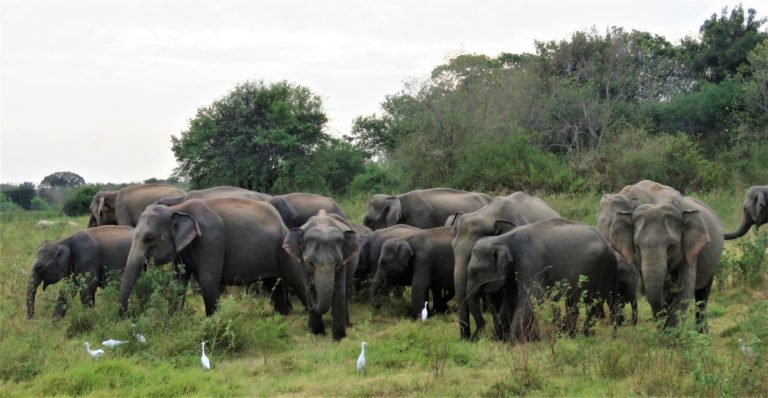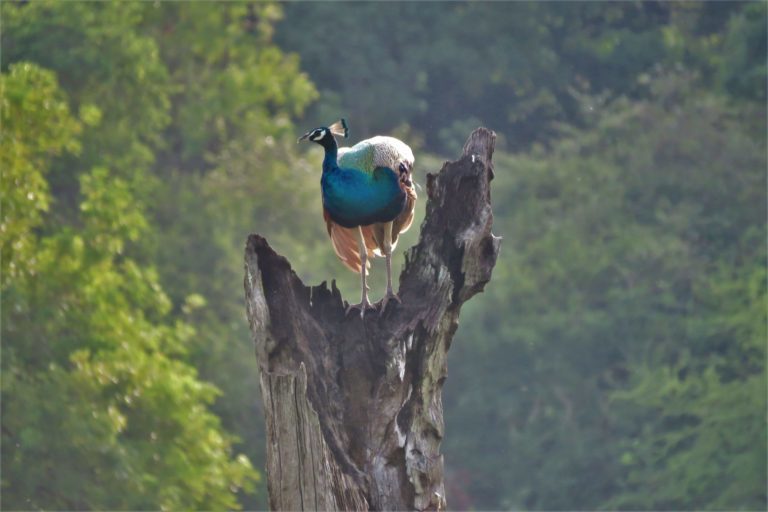- Farmers in Sri Lanka aren’t receiving training on how to deal with wild animals raiding their crops, despite human-wildlife conflicts growing more frequent as farms expand into wildlife habitats, according to a study.
- The study authors say it’s vital for farming communities to be able to protect their fields from crop-foraging animals, just as they do from smaller pests and weeds, for which there is already plenty of training.
- The study highlights non-lethal deterrence methods that farmers can use, ranging from decoys to scare off birds, to fences and hormonal secretions to keep elephants at bay.
HAMBANTOTA, Sri Lanka — Herathhami Dissanayake, 71, a rice farmer from Hambantota in southern Sri Lanka, says he’s despondent about the increase in wild animals raiding the crops in his village. He’s among dozens of farmers who continue to lose their crops to marauding herds of elephants and boars, and are suffering from the loss of income.
Herathhami says some of the old methods of keeping out crop raiders — elephants (Elephas maximus maximus), wild boars (Sus scrofa cristatus) and peafowls (Pavo cristatus) — no longer work, though it’s unclear why. All he knows, he says, is that the incidents have increased.
The real reason for the higher frequency of crop raids, a study suggests, is that farmers are encroaching deeper into animal habitats, making confrontations inevitable.
The study, published last October in the journal Crop Protection, took a deep look at human- wildlife conflicts in three rice-growing districts in Sri Lanka’s south and southeast. It also evaluated the quality of farmer training in these regions and whether methods to mitigate human-wildlife conflict formed part of capacity building there.
Lead author Finbarr G. Horgan, of EcolaVerna Integrated Restoration Ecology in Ireland, told Mongabay that expansion of farmland often resulted in encroachment into wildlife habitats, triggering conflict.
“Where the study was carried out, encroachment was due to farmers opening new areas for agriculture and also due to new settlements. Expansion may also have been due to infrastructural development including irrigation infrastructure and roads,” Horgan said.

Expanding agricultural frontiers
Sri Lankan farmers have been expanding the country’s agricultural frontiers while at the same time intensifying their farming practices, a trend seen across much of Asia. Many intensively farmed rice landscapes are located within biodiversity hotspots, posing a threat to wildlife conservation, threatening the maintenance of ecosystem balance, fragmenting natural habitats, and enabling hunters to more easily access wildlife populations, the study found.
“People draw closer to animal terrain and experience intensified human-wildlife conflict,” said Hematha Withanage, the executive director of the Colombo-based Center for Environmental Justice (CEJ), who was not involved with the study. “Increasing urbanization, shrinking wildlife habitats and several development initiatives are triggering the conflict.”
But the farmers themselves didn’t directly associate the increase in crop raids on the changes they were making to the habitats, although other studies have shown that farmers are aware of a decline in wildlife in areas into which they’ve expanded their activities.
A practical way to drive the message home is to make farmers aware of how clearing wildlife habitats for farmland makes them more vulnerable to being raided by wild animals and losing income, said study co-author Enoka P. Kudavidanage, the head of the department of natural resources at the Sabaragamuwa University of Sri Lanka.
She said the research tried to identify practical methods to help reduce crop damage, including cultural and technological innovations to protect crops and deter wildlife, effectively reducing farmer anxiety and helping ease human-wildlife tensions.

Training for farmers
The researchers cite farmer training as a key tool to helping them tackle crop raiding. Nearly two-thirds of farmers surveyed for the study said they already had some kind of training to deal with other threats to their crops: pests and weeds. But they didn’t receive training to deal with wild animals raiding their farms, the authors say, and tended to view this threat as less manageable than dealing with smaller vermin and weeds.
“Elephants can destroy your home but rodents can’t,” said Senanayake Herath, a rice farmer from Hambantota. Yet he acknowledged that most of the crop damage on his land was from insects.
For all that they perceived wild animals as a major threat, villagers showed restraint when dealing with them. They used loud noises, sometimes employing rustic early warning systems or neighborhood vigilance to keep them away. During the survey, farmers didn’t mention hunting or shooting of animals, in a reflection of their Buddhist tradition.
They also considered the use of noise, fire or light as highly effective to chase off animals. But they didn’t often consider the time lost or risk inherent in confronting large and sometimes aggressive animals, such as elephants, or that driving them away could create a problem for farmers elsewhere.
They also failed to see wildlife management as a cost to production, the way they saw weeds and pests, the researchers said.
With Sri Lanka’s human-wildlife conflicts set to increase, given ongoing development programs and habitat loss, the researchers are calling for non-lethal methods of minimizing conflict, using deterrence systems such as visual decoys, odors or sounds.
For example, scarecrows and owl or hawk decoys are traditionally used to deter birds, while temporin secretions, leopard urine or chili-based deterrents can be used to ward off elephants. In some cases, deterrent barriers can be useful, such as fences with chili odors, Horgan said.
“The alternative to deterrents are not always lethal, but are usually stressful for animals and/or humans and include loud noises like shouts and drums, strong lights and projectiles. Lethal methods include shooting, poisons and traps which should be avoided and are illegal,” he said.
Other common repellence practices can be harmful, such as stoning and chasing animals with firecrackers or drums. “Such activities can cause animals to panic and, with large animals like elephants, could result in charging and panicked animals causing damage to homes and other infrastructure,” Horgan said.
He also called for wildlife management to be part of the training curriculum that farmers currently receive, in addition to training on pesticide use and weed management.
“Farmers currently receive little training in wildlife protection and mitigation of wildlife conflict, so any relevant training would be an improvement,” he said. “Farmers could be given information on the relative vulnerabilities of crops, good fence management, deterrence methods and novel barrier and deterrence systems.”
Informing farmers of wildlife conservation needs, who they can turn to for help, and the consequences of injuring or confronting wild animals can help them better evaluate the utility of different methods, Horgan said.

Other helpful topics to include in training are land use management, and the value of pesticide-free insect and weed management, the study says.
It also calls for greater intergovernmental cooperation among key institutions, overcoming conflicting policies, improved farmer training, and more research and resources to improve wildlife management practices.
Citation:
Horgan, F. G., & Kudavidanage, E. P. (2019). Farming on the edge: Farmer training to mitigate human-wildlife conflict at an agricultural frontier in south Sri Lanka. Crop Protection, 127, 104981. doi:10.1016/j.cropro.2019.104981
Banner image of foraging elephants in a rice paddy field in Sri Lanka’s southern district of Hambantota, courtesy of Enoka P. Kudavidanage.
